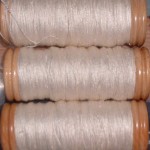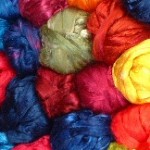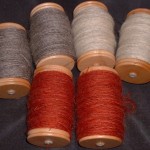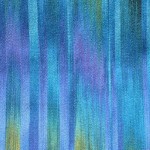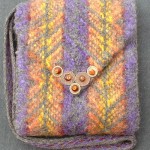As weavers, we all need yarn. We buy it, store it, categorize it, use it, learn about its properties, how it can be handled, and how to care for it once it is cloth. But as spinners? We have so many more options for yarn: we can choose the very fiber we wish to use, blend it with other fibers, add twist in either direction and in any amount, and add color in a variety of ways. Lucky indeed is the weaver who spins.
Fiber
Most of us as spinners start with wool. We can choose the fleece right on the sheep by contacting the fiber producers directly. Farmers bring their fleeces to us though too, at county fairs, spinning days, conferences and fiber festivals. All that fleece can be alluring: in raw form, the spinner can see lock formation, test a lock for soundness and hand, choose a fleece for color and grade from fine to coarse. Then the spinner can spin the fiber: by itself in one of its many natural colors, or mix and blend, dye it to whatever color and fiber combination she wants.
Alpaca, angora rabbit, mohair even dog hair are some of the other animal fibers readily available to spinners. The possibilities for blending these fibers with wool are endless: alpaca adds warmth and drape to wool, angora adds softness and a fuzzy halo to wool yarns, mohair adds luster, strength and drape: all these factors can be controlled to an amazing degree in the yarn a spinner makes: carding more or less of each fiber until she has just the right combination for her project.
We live in a state where cotton is grown extensively for commercial mills: making it also just the right climate for us to grow our own little crop of fluffy fiber. Cotton can be easily spun directly from the boll, pulling the fibers gently away from the seeds, adding twist while drafting out a miraculously thin and stable thread, or the spinner can remove the seeds, card the lint into rolags or punis, and spin it up as a fine yarn, ply it, dye it and weave it. Best of all, our climate is not only conducive to growing cotton, but also to wearing cotton!
We can try silk in Bombyx (cultivated silk, a very white fiber), Tussah (and semi-cultivated wild silk in a range of golden beige colors), or wild silks such as Muga, or Eri. Silk may seem pricey per ounce, but the hours of spinning pleasure make it a bargain fiber, and at the end of all that spinning time you have…silk! It is similar to cotton for spinners: a slick fiber that needs lots of twist to hold it together, and the result is shiny, drapable and lightweight fabric woven up from a fiber we can also wear all year around.
Twist and grist
Spinners can spin our yarn any size we want. That seems an obvious enough thing, but it has real potential as a weaver: the same fiber, wool, alpaca, silk or cotton, but singles, two ply, three ply, or whatever combination we want. Spinners can weave a simple two ply twill fabric, with a few warps of three ply in the same fiber spaced periodically across the web, and woven with singles in the same fiber. These are yarns that would be hard to find commercially, and yet we can make them at any time.
How will a 3 ply affect the fabric? We used to have a commercially available yarn from Oregon Worsted company in a fine 3 ply wool. The company is no longer producing, but we can make the yarn ourselves, in any wool, alpaca, or Pygora. And what if we make the fine 3 ply in silk? Silk, spun fine, with multiple plies, will drape and still make a substantial fabric: for chair seat covers, bags, cushions, or a coat.
Spinners can twist fibers in more than one way: either by switching the direction of twist, adding additional twist or using multiple plies. How does direction of twist affect the fabric you are weaving? Can you change the surface of the fabric by changing the amount of and direction of twist of the yarns you use in the warp or weft? Collapse fabric uses twist to create an undulating surface: combined with yarns of less twist the fabric surface can be manipulated in both warp and weft direction.
We can alter commercial yarns to be more suitable for our project: add twist or remove twist, re-ply with another strand, or ply two yarns together. Altering a commercial yarn is a good way to begin the process of using handspun yarns for the timid: once a spinner realizes the potential of custom yarns for her fabric, a whole world opens in fabric design and weaving.
Color
Fibers come naturally in a dizzying array of colors: white, cream, beige, green and brown cottons, gray wools in a variety of depths of shade, and pure black alpaca. Spinners can use them as is, blend them to get gradations of natural colors, or dye them in the fiber or as yarn. Dyed fibers can be blended with others before spinning, creating gradations and custom colors. Dyed colors can be plied with another color entirely, or three or four plies can all be coordinated one skein to another, gradually moving from one colorway to another across the web. No one in the fiber world has more color options than the spinner!
But is it hard to use handspun yarns for weaving? No! The yarns just need to be sound. As weavers, we can start with the yarns we use anyway: I use two ply yarns most often. Singles might need a sizing to stabilize them for the warping and weaving process, but for collapse fabrics, the singles just need to be under control as the loom is warped and the fabric is woven. Phyllis Karsten has written an excellent book on using handspun for weaving called From Fiber to Fashion; Spinning, Weaving, Sewing. The book covers the process of spinning and sizing singles of wool and cotton for weaving, then finishing and cutting the fabric, and tips for sewing. It is an encouraging and information packed self-published book, available directly from her at pkarsten(at)pkarsten.com.
Spinners today have an extensive range of ready-to-spin fibers available to us at one of our many shops or farm stores. Carolina Homespun in San Francisco is a pre-eminent dealer of all things fiber for spinners, carrying tools and equipment, and also a wide range of fibers. A Verb for Keeping Warm is an Oakland-based fiber and equipment supplier using natural dyes for subtle colors on fibers for spinners. There are many more fiber suppliers listed on the CNCH website.
Spinning opens doors to all sorts of possibilities for the weaver, the options are truly unlimited. We can use simple spindles, or any number of beautiful and practical spinning wheels produced by manufacturers big and small. We can make yarn just like the types of commercial yarns we already use: wool, cotton, linen, silk in singles and two plies. Or we can add to or alter the yarns we buy, we can reproduce long out-of-production yarns, we can make custom colors and fiber blends, and twist the yarns in any manner of ways to affect the fabrics we weave. We can select fibers that will shrink differentially, or spin them to do so. We can use singles, two plies, or multiple plies in the same fibers in our fabrics, making custom yarns that no mills produce. We can truly customize our fabrics when we spin to weave.
Sara Lamb is a Northern California Weaver, spinner and dyer, the author of Woven Treasures from Interweave Press (2009) and a new DVD Spinning Silk, (2012), Interweave Press. She is currently working on her second book: Spin to Weave, due out in Spring 2013 from Interweave Press.
Click HERE for the next article
